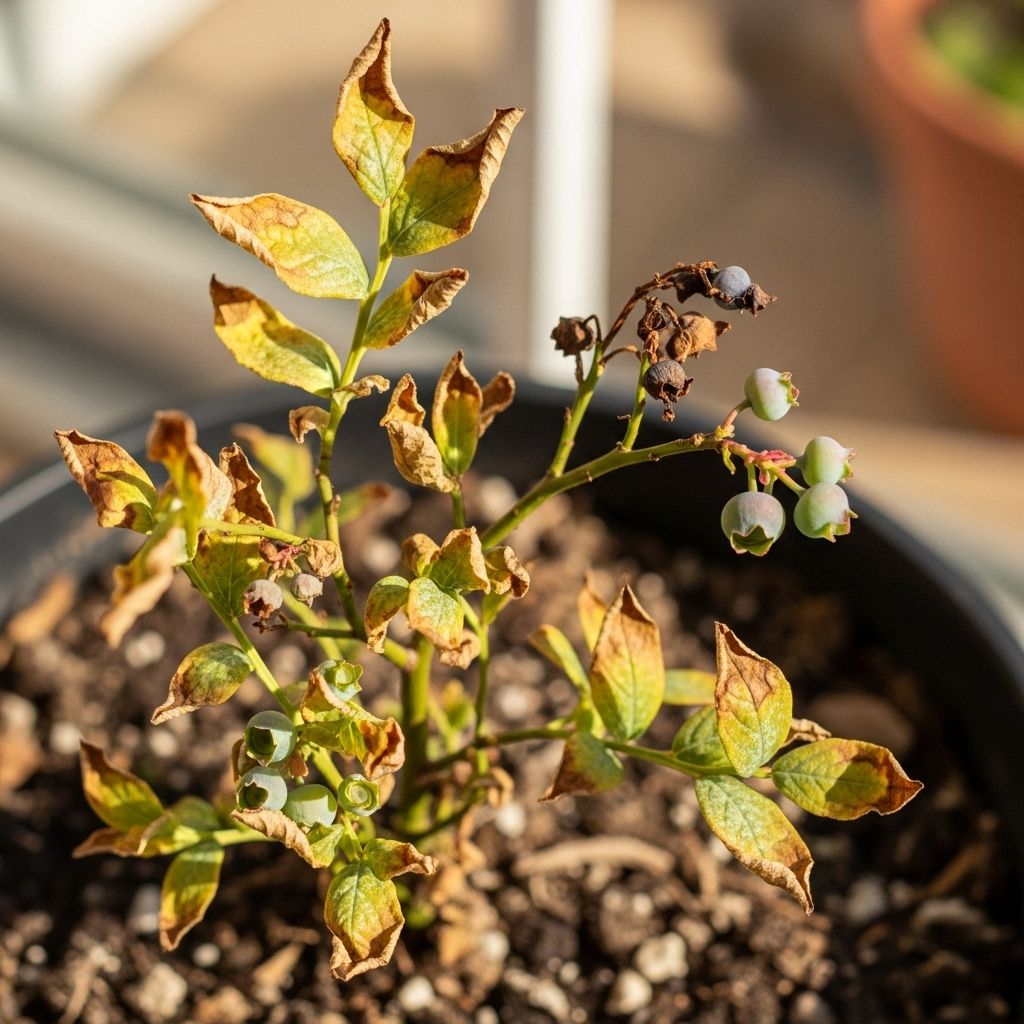Why Is My Blueberry Plant Dying? Causes, Solutions, and Expert Care Tips
Balanced soil care and watering restore health and boost fruit production.

Image: HearthJunction Design Team
Is Your Blueberry Plant Dying? Understanding Common Causes and Solutions
Blueberries are popular among gardeners for both their delicious fruit and ornamental value in the landscape. However, even experienced growers can face the frustration of a blueberry plant that suddenly takes a turn for the worse. Before you give up on your blueberry bush, it’s crucial to identify what’s causing the problem and explore proven solutions. This guide will walk you through common symptoms, underlying causes, and practical remedies for reviving a struggling blueberry plant and ensuring future harvests remain abundant and healthy.
Contents
- Recognizing Signs Your Blueberry Plant Is Dying
- Common Reasons for Blueberry Plant Decline
- Step-by-Step Solutions to Revive Your Blueberry Plant
- Ongoing Care Tips to Keep Blueberry Plants Healthy
- Frequently Asked Questions (FAQs)
Recognizing Signs Your Blueberry Plant Is Dying
Spotting the early warning signs can make the difference between saving and losing your blueberry bush. Here’s what to look for:
- Leaves turning red, yellow, or brown: Discoloration or scorched spots are common symptoms of stress.
- Wilted, drooping foliage: Wilting may be due to underwatering, heat stress, or root problems.
- Stunted growth: Plants that stop producing new shoots or leaves may be lacking key nutrients or have root damage.
- Leaf drop: Sudden or premature leaf loss can be caused by disease, drought, or natural seasonal changes (blueberries are deciduous, so fall leaf drop is normal).
- Dead branches or entire plant sections: Dieback may signal severe root or stem problems.
Common Reasons for Blueberry Plant Decline
There are several underlying issues that can cause a blueberry bush to decline. Identifying the root cause is essential for effective treatment:
Improper Soil pH
Blueberries need acidic soil with a pH between 4.5 and 5.5. If the soil pH is too high (alkaline), the plants cannot absorb nutrients properly, leading to chlorosis (yellowing leaves), poor growth, and ultimately death.
Solution: Test soil pH and use amendments such as sulfur or acid-based fertilizers to lower the pH if necessary.
Tip: Regular pH checks are crucial for long-term blueberry health.
Poor Drainage or Improper Watering
- Drought Stress: Blueberries are shallow-rooted and require consistently moist (but not waterlogged) soil; drought can quickly stress and kill a plant.
- Overwatering: Roots can rot if left in soggy soil. Root rot symptoms include overall plant decline, wilting, and death of branches.
Solution: Maintain an even watering schedule. During dry spells, water deeply once or twice a week, and ensure good drainage. Mulch to help retain moisture and protect shallow roots.
Lack of Mulch
A 2-inch layer of mulch is recommended to help blueberry bushes conserve moisture and keep roots cool. Bare soil can lead to dehydration and root damage.
Organic options: Pine bark, pine needles, or acid-loving plant mulch.
Insufficient Sunlight
Blueberries thrive best with at least six to eight hours of direct sunlight per day. Too much shade reduces vigor and fruit production, and makes plants more prone to disease.
Nutrition Deficiencies
Deficiencies in iron, magnesium, or nitrogen can cause yellowing leaves and stunted growth. Blueberries are sensitive to overfertilization; use products formulated for acid-loving plants (e.g., Espoma Berry-tone).
Root Establishment Problems
Newly planted or transplanted blueberries may fail to establish proper root systems, especially if planted in unsuitable soil or deprived of adequate water.
Winter Damage or Extreme Temperatures
- Winter injury: Cold weather can injure or kill stems, causing dieback in spring.
- Heat stress: Excessive heat, especially in containers, can cause root damage and dehydration.
Solution: Locate plants in a sheltered area, mulch well, and shade containers as needed.
Disease and Pests
Although less common than abiotic causes, fungal pathogens (such as root rot and stem cankers) or pest infestations can stress and kill blueberries. Prune out diseased material promptly.
Step-by-Step Solutions to Revive Your Blueberry Plant
- Diagnose the Problem
Examine symptoms, check soil pH, inspect roots, and assess plant placement for light and airflow. - Adjust Watering and Mulching
Keep soil evenly moist but never waterlogged. Add a 2-inch mulch layer around (not touching) the stems to insulate roots and retain moisture. - Test and Amend Soil
Use a soil test kit to verify pH and nutrient levels. Amend soil as needed with elemental sulfur or acid-boosting organic matter. - Feed Appropriately
Fertilize with a gentle, organic fertilizer labeled for berries just once in early spring, and avoid high-nitrogen or alkaline products. - Prune Dead or Diseased Wood
Use clean, sharp pruners to remove all dead branches and diseased tissue, cutting down to healthy wood or close to the soil line as appropriate. - Protect from Temperature Extremes
In hot climates, shade container sides or relocate pots to a cooler spot. Mulch and site selection are key for winter cold protection. - Patience with Seasonal Changes
Remember, blueberry bushes are deciduous and will lose their leaves normally in autumn. Only intervene if problems persist beyond seasonal cycles.
Blueberry Care Troubleshooting Table
| Symptom | Possible Cause | Suggested Fix |
|---|---|---|
| Yellowing leaves | High pH, iron deficiency, overwatering | Check pH, amend soil, ensure proper drainage |
| Brown/drying leaf edges | Drought, salt buildup, root burn | Water evenly, leach salts, adjust mulch |
| Leaf drop (out of season) | Root rot, severe drought, disease | Inspect roots, reduce water, prune diseased wood |
| Poor fruit set | Insufficient sun, nutrient deficiency | Relocate, fertilize for acid-loving plants |
| No regrowth after dieback | Dead roots or severe winter kill | Replace plant, improve site conditions |
Ongoing Care Tips to Keep Blueberry Plants Healthy
Preventing plant decline is always easier than recovery. Implement these care practices for thriving blueberries:
- Monitor and Adjust Soil pH annually; amend as needed.
- Apply Mulch to maintain steady soil temperatures and moisture.
- Water thoroughly, especially during dry spells or high temperatures, but never let soil become soggy.
- Fertilize once yearly with an organic, acid-formulated fertilizer in early spring.
- Prune out dead wood every spring to keep the plant healthy and promote new growth.
- Consider plant age: Older bushes tend to be more resilient but benefit from periodic rejuvenation pruning.
- Provide full sun for at least 6 hours daily, but, in hot climates, offer some afternoon shade to containers.
With these principles, you can extend the productive lifespan of your blueberry plant and enjoy consistent, flavorful harvests.
Frequently Asked Questions (FAQs)
Q: My blueberry bush lost all its leaves—is it dead?
A: Not necessarily! Blueberries are deciduous and naturally shed their leaves in the fall. If it’s out of season or the stems are brittle and dry, check for root health; but if foliage is dropping in autumn, it’s perfectly normal.
Q: How should I fertilize my blueberry plant?
A: Use a fertilizer specifically formulated for acid-loving plants (like organic berry fertilizers) once in early spring, before new growth emerges. Avoid over-fertilizing as blueberries have delicate roots and can be easily burned.
Q: What kind of mulch is best for blueberries?
A: Organic mulches like pine bark, pine needles, or specialty acid plant mulches are ideal. They help acidify soil over time and retain soil moisture.
Q: My blueberry leaves are turning yellow at the edges—what does this mean?
A: This could be a sign of high pH (nutrient lockout) or iron deficiency. Test your soil pH with a reliable kit and amend the soil to achieve the optimal range of 4.5 to 5.5.
Q: What should I do if my plant shows no regrowth after dieback?
A: If stems are crisp and brown throughout and there’s no sign of new shoots, the root system may be dead. Remove the old plant, address the underlying soil or care issues, and start over with a new, healthy bush.
Final Thoughts
Growing blueberries brings sweet rewards, but these plants require specific conditions and attentive care. If your blueberry bush is struggling, don’t lose hope—most issues can be pinpointed and corrected with patience and consistent effort. By understanding the root causes and applying the solutions above, your plant can revive and reward you for seasons to come.
References
Read full bio of Anjali Sayee












